September 20, 2010
I alway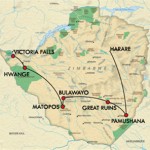 s feel in a state of limbo when I come back from a long-haul flight. There is that lull between landing and pushing open the front door which can seem a bit surreal; and then life returns to how it was before, albeit with the addition of some wonderful memories and experiences.
s feel in a state of limbo when I come back from a long-haul flight. There is that lull between landing and pushing open the front door which can seem a bit surreal; and then life returns to how it was before, albeit with the addition of some wonderful memories and experiences.
Tourism in Zimbabwe has been in a state of limbo for over ten years. Politically and economically the country has been a disaster, and so the British (in particular) have been reluctant to go there. But the infrastructure is still there, and I have just motored over 1,500 miles in a Toyota Familia on roads that are smooth and carry little traffic. When I wanted to check the directions (sure, some of the sign posts have been removed or purloined), I was greeted by warm, friendly and extremely helpful people. Even the police were most courteous as they extracted some $20 from us for speeding on a long and tempting empty road…but that may have been because one of my travelling companions gave them our delicious homemade choccie biscuits!
M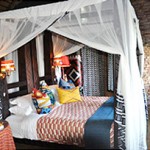 y journey started at the vibrantly decorated and beautifully managed Pamushana Lodge operated by the Singita collection.
y journey started at the vibrantly decorated and beautifully managed Pamushana Lodge operated by the Singita collection.
It is located in the far south of the country on a 160,000 acre concession owned by the Malilangwe Trust. This is a conservation story in itself: the trust is funded by a very rich man indeed with a serious preservation mission which means no expense is spared in giving guests a fantastic time. More to the point, you can fly into a tiny international airport called Buffalo Range direct from Johannesburg and be at the lodge 45 minutes later which makes it a brilliant place to go as a stand-alone destination linked to something else in South Africa. Even more to the point, I saw the Big Five in one day here; tracking a young leopard as it stalked a number of impala (unsuccessfully in the end) was quickly followed by watching a pride of lion on a kill, with hyena circling, awaiting their turn and at times being chased off.
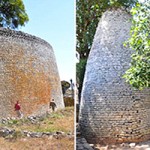 Moving west I visited the great ruins which are Zimbabwe’s equivalent of the pyramids and the largest ancient stone structures south of Egypt.
Moving west I visited the great ruins which are Zimbabwe’s equivalent of the pyramids and the largest ancient stone structures south of Egypt.
The country is now named after them. Once home to a thriving trading empire it was at its zenith when the Black Death was ravaging England. Artefacts from China have been found on the site. No one can fail to be impressed by the stone walls, some of which are eleven metres high and five metres thick. Archaeologists still puzzle over a ten metre high conical tower. Is it a grain bin or a phallic symbol?
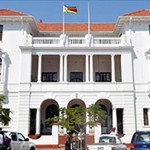 In Bulawayo, the country’s second city, I wandered about the centre and felt completely safe. Ladies were sassily sporting the latest brightly coloured fashions, and guys looked buff. It felt distinctly upbeat.
In Bulawayo, the country’s second city, I wandered about the centre and felt completely safe. Ladies were sassily sporting the latest brightly coloured fashions, and guys looked buff. It felt distinctly upbeat.
The Bulawayo Club was on its knees until last year when a local family took a management contract from the members and revived its spirit and the standard of comfort it provides. It offers a fascinating time-warp with its antique furniture, memorabilia and photographs from the old colonial world.
Our guide Paul, who seemed to have a fistful of degrees in archaeology and is able effortlessly to communicate his enthusiasm for the history of his country, is potentially the new David Rattray of Zimbabwe. Incidentally, the National Railway Museum here has one of the best railway engine collections in the world.
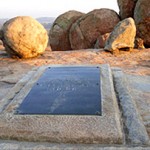 Later, Paul took us to the Matopos Hills where we stood by Cecil John Rhodes’ grave and were told about the elaborate plans he made for his interment. It took some ten days to transport his body from Cape Town where he died in March1902 to the site. Eventually three coffins, one inside another, were needed (reassuring if you think about the heat at that time of year in Africa).
Later, Paul took us to the Matopos Hills where we stood by Cecil John Rhodes’ grave and were told about the elaborate plans he made for his interment. It took some ten days to transport his body from Cape Town where he died in March1902 to the site. Eventually three coffins, one inside another, were needed (reassuring if you think about the heat at that time of year in Africa).
Rhodes, a hugely rich entrepreneur at a young age, was of course a conspicuous force in the expansion of British territories in Southern Africa. He probably was responsible for ensuring Bechuanaland (now Botswana) remained a British possession instead of falling to the Boers. It is quite extraordinary that only a hundred years ago a rich mining magnate was able to insist that a country was named after him. We also heard tales of the last stand of the Shangani patrol (1893) – a heroic event that gave Rhodesia its first white martyrs. These historical tales have a particular poignancy when you are standing on the very spot where they occurred listening to a guide who is passionate about his subject.
 Moving north, I visited Hwange National Park, surely one of the best places to see concentrations of elephants in the dry season. At one authentic bush camp I visited, the swimming pool had become the elephant pool, and the guests sipped their G and Ts and nibbled bitings less than ten feet from a thirsty bunch of even larger mammals.
Moving north, I visited Hwange National Park, surely one of the best places to see concentrations of elephants in the dry season. At one authentic bush camp I visited, the swimming pool had become the elephant pool, and the guests sipped their G and Ts and nibbled bitings less than ten feet from a thirsty bunch of even larger mammals.
Two years ago when I last visited Victoria Falls it was a ghost town; now, with the Zimbabwean dollar consigned to the rubbish dump and hard currency in play, the shops are full, the streets are bustling and the terrace of the Victoria Falls Hotel (the grand old lady of the Falls hotel industry) is alive with the sound of clinking cups and saucers and the gentle munching of cucumber sandwiches.
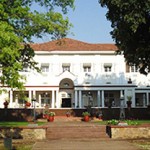 I really did find it a thrill to see Zimbabwe’s tourist industry working again. The game is still there, the guides are some of the best in Africa, and the historical dimension is a major attraction. Fortunately, I only managed to travel to the south and west of the country which means I have to go back and check out the north and east.
I really did find it a thrill to see Zimbabwe’s tourist industry working again. The game is still there, the guides are some of the best in Africa, and the historical dimension is a major attraction. Fortunately, I only managed to travel to the south and west of the country which means I have to go back and check out the north and east.
NB prices shown were current at the time of writing the newsletter and are not necessarily current now.
Please ask for an updated quote.
- The Khajuraho temple complex, a Unesco World Heritage Site
- A Sense of Place: Poignancy in KwaZulu Natal
- A Sense of Place: Northern Botswana
- A Trio of Treats in India
- And now for something completely off grid and different: AFRICA’S ULTIMATE RAINFOREST SAFARI
- A Trio of Treats off the beaten track – We get you to places that others don’t!
- A Trio of Treats On The Rift Valley
- A Sense of Place – Can the muppets save a species?
- Trio of treats (Rajasthan, Maldives and Garden Route)
- A Sense of Place – A favourite place: Tanzania and Ruaha
- A Sense of Place – A favourite place in Botswana: the Okavango with elephants galore
- A Sense of Place – Here be dragons and a dark past
- A Sense of Place – Justice Regained
- A Sense of Place – Summer rains make the roads impassable
- A Sense of Place – ‘Those two ladies put light in my future.’
- A Sense of Place – The bird who lost its nest
- A Sense of Place – Talking with the Maasai
- Newsflash: first American guests to Tanzania since March 2020
- A Sense of Place – AFRICA NEEDS YOU
- Escape to Italy?
- Covid: the road still to be travelled.
- A trio of treats. Series of 3 (Part 3): Tiger reserves.
- A trio of treats. Series of 3 (Part 2): Khajuraho.
- A trio of treats. Series of 3 (Part 1): Lucknow.
- A Sense of Place – Engaged people may save the planet
- A word on lions and a trio of treats
- A Sense of Place – India’s most holy city
- A wealth of wilderness walks in Namibia
- Travel snippets from Miles
- A trio of treats on the green island of Pemba in the Zanzibar archipelago
- A Sense of Place – THE INSIDE TRACK on Cape Town guiding
- A Sense of Place – Migrations of people and beasts: East Africa
- A Sense of Place – An era of revolution and global alliances
- A Sense of Place – A walk on the wild side
- A Sense of Place – The ghost ingredient is back
- A Sense of Place – Liuwa Plains and Kafue National Parks – Zambia
- A Sense of Place – Literati in the Pink City, the Capital of Rajasthan
- A Sense of Place – A Tamil town still connected to Europe, Art Deco architecture, and temple antiquity in Southern India.
- A Sense of Place – Dreamy aquamarine sea and stunning safari with the Makuleke people
- A Sense of Place – A trio of lovely ladies in Hyderabad
- A Sense of Place – Entamanu, the wishing tree and walking with the Hadza tribe.
- We get you to places that others don’t… St Helena, Gt Zimbabwe ruins and Papua new Guinea
- A Sense of Place – Walking in the hippie hills of the Himalayas
- A Sense of Place – The Okavango: the river that never finds the sea
- A Sense of Place – The Great Rift Valley, Laikipia, Samburu warriors and Maasai Olympics.
- A Sense of Place – Escape the world in the Namib Desert
- Africa is a massive continent: a collection of 55 countries
- A Sense of Place – Zambezi Watery Wilderness
- A Sense of Place – Burma: the road beyond Mandalay
- Lake Malawi – Would you rather pay for the advertising or the experience?
- From shoe-shine boy to tourist guide in Ethiopia
- A Sense of Place – Ladakh, the Himalayas
- Dhow sailing, Lions are back in Malawi, Self-drive in Namibia
- Sacred rivers and forts, India
- Piranhas, sting rays, caimans – and still people go into the River Negro!
- Kerala, Southern India – God’s own country
- South Africa: Crucible of the rainbow nation
- Madagascar: croissants and lemurs
- Argentina vs Africa on wildlife drama
- Uganda – Gorillas and Gardens
- Mozambique & Kenya: immigration official on holiday
- Mozambique: Gorongosa and reconciliation in the bush
- Zimbabwe is ready for Tourists again
- Serengeti ecosystem and unbeatable savannah
- Lamu: crab complaining
- Kenya: circumcision
- Zambia: Ellie rescue
- Africans: always smiling
- Tswalu
- French sketch
- Kenya: the best hosts
- First visit to Africa 1986
- Namibia, Namib Rand, Skeleton Coast and the ultimate flying safari
- A few gems off the beaten track: Fanjove Island, Tanzania; The Singular Hotel, Patagonia and Isla Palenque, Panama.
- Elephant relocation, quad bike expedition and new Sossusvlei reserve
- Templed out in Tamil Nadu and elephant refuge in Jaipur
- Kenyan sanctuary and family run camp in Zambia
- Australia: Arkaba, Tasmania and Lord Howe Island
- Australia: in the outback and off the beaten track
- India: heavenly Himalayan hideaways, Botswana: fun safari for children and Argentina: hidden homestay in a mountain desert
- Limpopo retreat, Serengeti spectacle and adventure on the Zambezi
- Value for money in Kenya and the trail less travelled in Peru
- Lions in danger, free nights and a new coastal gem
- G and T on demand, hidden beach, micro-light and sleeping on a dam
- Off the beaten track